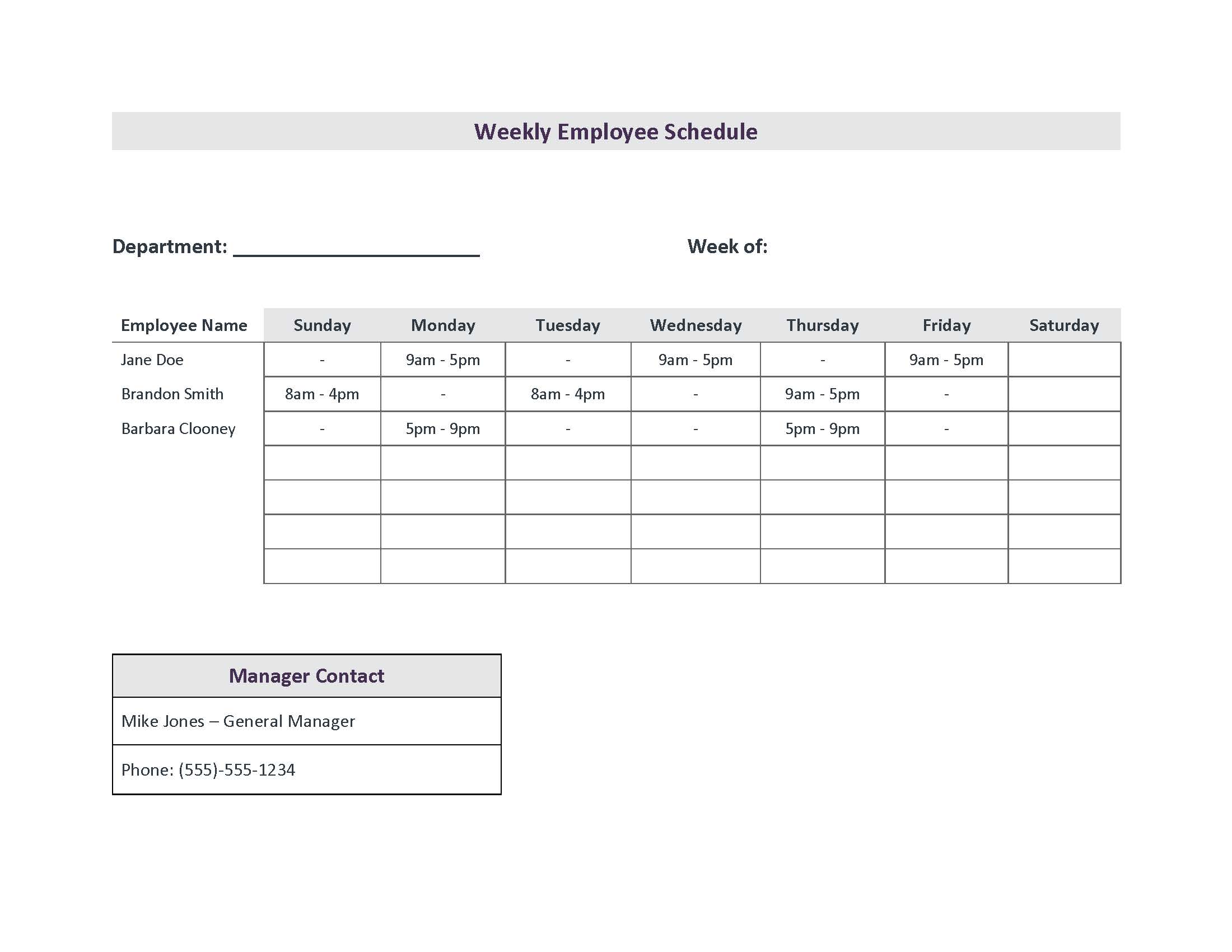

There are few things as frustrating to a small business as a poorly managed work schedule. Finding the best work schedule for your team is an integral part of your business’ success—not to mention your employees’ happiness —and creating a work schedule template using Microsoft Word is one of the simplest solutions you can choose.
Here’s how to go about using Word in your scheduling (including our downloadable template), as well as other alternatives you may want to consider. But first, let’s dive into what makes a work schedule work for you.
A work schedule is a list, calendar or table detailing the days and times when an employee is expected to work, and (in some businesses) which tasks they’ll be performing. A well-designed work schedule keeps your business properly staffed at all times, without overburdening any one person with too many hours and causing burnout. Work schedules can include flexible work hours, rotating shifts, fixed or split schedules and are used for both full-time and part-time work.
There’s a lot of variety in work schedules across different kinds of businesses and industries. Where many customer-facing businesses will use standard schedules to operate five days a week and eight hours a day, other businesses will opt for an alternative schedule to maximize profitability, putting in time or offering services outside of typical hours.
Work schedules reset either weekly, monthly, or with a different system, depending on which will best meet the needs of a business and its employees.
While you can certainly go off-book, we’ve outlined some of the most common ways of working and shifts for small businesses below.
An hourly schedule template, sometimes called a daily planner template, plans out an employee’s day on an hourly basis. People working from home can especially benefit from using this scheduling approach, as can service businesses that assign people to specific tasks throughout the day and want to specify breaks.
A weekly work schedule details a team’s work organization over a period of one week. A classic weekly work schedule template will include a column for employee names and assignments and columns for each day of the week, with or without weekend days depending on when a business operates.
A monthly work schedule is a plan that lays out the tasks and goals that a team needs to accomplish within a given month. It visualizes the team’s priorities and is often used as a management tool to help supervisors allocate staff in the most effective way.
A 24/7 work schedule template keeps track of employees throughout an entire seven-day workweek. This kind of schedule is typically used in service businesses like manufacturing firms, senior care providers and security agencies, and ensures shift coverage at all times of the day.
Also known as flextime or flex schedules, flexible work is a work arrangement designed to give employees more control over their work-life balance and promote job satisfaction, while still meeting the needs of your company.
Business owners or managers can set the minimum number of work hours expected, but employees can choose to clock in or clock out earlier or later than the set hours, as long as they fulfill the required total hours for a given period.
And these days, of course, in-office businesses may let their employees choose a combination of in-person and remote work, approving people’s remote work requests for a certain number of hours or days each week.
Using a structured work scheduling system benefits both small business owners and their teams in several important ways. Here’s how effective employee scheduling keeps your business running successfully and smoothly:
Businesses just can’t function effectively without everyone being in the right place at the right time. With a well-designed schedule, no tasks get overlooked or forgotten—you’ll always have the right people available, and the customer experience will remain consistently smooth.
With less time wasted fixing problems like shift conflicts, you can put more of your time and attention into other parts of your business.
Unlike traditional to-do lists and planners, work schedules encourage time blocking—a way of managing tasks by chunking time into blocks, which are then allocated to an activity. Time blocking helps employees improve their focus and reasonably estimate the tasks they can do on a given day.
Employees perform best when they know what’s expected of them. When people are uncertain about their schedules, they’re apt to show up early, late, or not at all. Inconsistent or unpredictable schedules negatively impact employee morale, making it more likely that people feel like they’re failing at their jobs.
Properly designed work schedules lead to a better work–life balance and measurably higher productivity .
With fair, predictable, and transparent scheduling, employees feel more satisfied that their needs are being met. They understand why they have the schedules they do, and they won’t end up feeling resentful about perceived favoritism if they get a less desirable shift at times.
When you’re systematic about organizing shifts, you’re helping establish higher employee morale and correspondingly higher retention rates.
When you have unpredictable schedules, attendance issues are harder to spot: it’s not as easy to see patterns like an employee being consistently late on a certain day. An established work scheduling system means you’ll notice a team member who’s struggling to start on time—and take action to resolve punctuality issues —much sooner.
The moment you add a scheduling template to your scheduling process, you’ll find that the entire process of managing everyone’s shifts and tasks is much speedier. All forms of work schedule templates will help you make the process faster and more accurate than when you were starting from scratch.
The familiarity, ease-of-use, and affordability of Microsoft Word makes it a great basic tool for creating your schedule templates. For small business owners looking to keep costs down, Word may be an especially appealing option.
To create your work schedule template using Microsoft Word, get started by following these simple steps:
When making your initial template, be sure to include headings with the following basic information:
Once you’ve created your work schedule template in Word, store the custom-made template on your computer. When it’s time to make a new one, just open the file, fill it out, and save it by date under a new filename.

Beyond Microsoft Word, another kind of software or interface could also be a good fit for your small business. Alternative work schedule template tools include Excel, Sheets, and Google Docs.
While manually created templates are a significant improvement to an ad hoc scheduling system, they’re still time-consuming and error prone. Plus, you can’t make quick edits or notify your team if rescheduling occurs. You’ll need to re-share info or let your team know in someway. Then you’ve got to ensure everyone’s actually seen the changes. A hassle? You bet.
Tracing older spreadsheet versions can also become a hassle. As spreadsheets can be edited by anyone with access, it can be hard to see which team member made the most recent changes. Even if your online spreadsheets have a version history, they’re usually downloaded and then forwarded using email.
Another thing to consider is technology preferences and user-friendliness. More and more, mobile devices are the expectation, and manual templates can quickly start to feel like an inconvenience.
Work schedule templates using Word and similar tools may accommodate the needs of a single-location business or a small team… But once your team expands, or you begin scheduling workers across multiple locations, you may find they no longer meet your needs.
That’s where Homebase’s employee scheduling tool comes in—starting with our free weekly schedule template .
Making the switch away from old-school spreadsheets may seem daunting. Luckily, Homebase was built with small business owners like you in mind. Homebase is quick to onboard and intuitive enough to learn with minimal guidance.
Once you input your team members’ roles, availability and preferences, Homebase’s free employee scheduling feature lets you create weekly schedule templates automatically.
By automating your schedules with Homebase, you’ll easily avoid shift conflicts. You’ll reduce the time and effort you put into your scheduling process. And it’s easy to make smooth last-minute changes when someone calls in sick.
What’s more? Our free plan also includes tools for time tracking and clocking in and out. Plus, keep your team in sync with our free, in-app team communication tool .
For small businesses looking for an efficient, affordable way to approach scheduling strategically, Homebase is the ideal scheduling solution to optimize your business and keep your team happy.